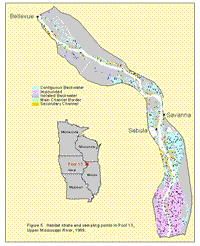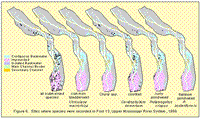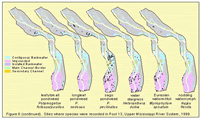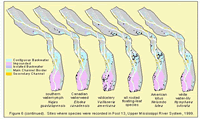1999 Results in Pool 13 of the Upper Mississippi River
Sampling Efforts
There were a few delays because of� weather for this sampling period.� Most of the delays this year were from malfunctioning global positioning system (GPS) equipment or an extremely large silver maple seedling germination on our forestry sites taking 2 days away from stratified random sampling (SRS).
Sampling was completed in a total of 29 working days beginning on June 16, 1999, and ending on July 27, 1999 (Figure 5). Of the 550 SRS sites sampled, five of the isolated backwaters were extremely challenging.
The minimum number of sites sampled was two because of testing of a new GPS unit for accuracy and effectiveness.� The maximum number of sites sampled in a day was 46 (most were nonvegetated impounded sites) while the average number of sites sampled was 19.�Two times we sampled more than 40 sites in a day, and five times we sampled more than 30 sites. Three different boats were used to complete this sampling:� the tunnel boat, canoe, and airboat, with the airboat used 90% of the time.
Water levels remained higher than the 35-year mean of 7.89 ft. during our sampling session making it easier to reach some sites.� Some sites were too deep to sample with the rake and the water was turbid.� Water levels—during this sampling period—started out slightly above 11 ft., dropped to around 8.50 ft. for 2 weeks, and increased to 11 ft. about the last 2 weeks of sampling.
Air temperatures during this time were in the 80s and 90s and humid!
Submersed Aquatic Vegetation
The abundance and frequency of submersed aquatic vegetation (SAV) varied among strata sampled.�Isolated backwater sites had the highest abundance and frequencies of SAV with 19.1% and 56.7%, respectively, followed by contiguous backwaters and impounded sites (Table 4; Figure 6).� The SAV was rarely sampled in the main channel borders and secondary channels with frequencies at 11.4% and 10%.�The SAV covered about 42% of the shallow water areas poolwide.
A total of 14 species of SAV were collected in Pool 13 in 1999.� Impounded sites contained the highest number of species with 12 present.� Contiguous and isolated backwater sites contained the next highest with 11 and 10, respectively.� The main channel border contained the least number of species with 4.�The secondary channel sites, even though they exhibited a low frequency, contained 7 species.�Sago pondweed was the dominant species in the backwater contiguous, main channel border, and secondary channel sites.� Coontail was the dominant species in isolated backwater sites followed by sago pondweed at 56.7% and 33.3%, respectively.� Wildcelery was the dominant species in the impounded area with 26.2% frequency followed by sago pondweed and water stargrass at 21.9% and 21%.� Eurasian watermilfoil was not encountered in the isolated backwater sites.
Rooted Floating–Leaf Vegetation
American lotus and white waterlily are the only two rooted floating-leaf species encountered in Pool 13 and were sampled in all but the main channel border and secondary channel sites.� Rooted floating–leaf species were encountered more often in backwater contiguous areas with 37.1% frequency than in isolated backwater areas at 33.3%.� The two species together covered about 7.4% of the shallow water areas or areas where water depth measured 3 m or less at flat-pool.
Notable
Water levels this spring and summer were higher than normal in Pool 13.� Late spring flooding was attributable to two torrential rainfall events causing the pool to rise and crest on May 19 at 14.69 ft.� Water levels remained above 14 ft until June 3 and by June 11 water levels dropped quickly to around 10.7 ft.� Late summer flooding was attributable to heavy rains in the northern watersheds.� Water levels were still in the 11- to 10-ft range through August 6 and dropped to 8 ft by August 11.� By August 17, 1999, water levels were down to 6.8 ft, a typical summer level.
Table 4.� Percent frequency,� abundance index (AI), cover, and standard errors of submersed and rooted floating–leaf vegetation in Pool 13, Upper Mississippi River System, 1999.|
Common name
(Scientific name) |
Contiguous
backwater n = 170 |
Isolated
backwater n = 30 |
Impounded
n = 210 |
|||
|
Freq.
|
AI
|
Freq.
|
AI
|
Freq.
|
AI
|
|
| bladderwort, common (Utricularia macrorhiza) |
-
|
-
|
10.0 � 5.6
|
1.3 � 0.8
|
-
|
-
|
| chara (Chara spp.) |
-
|
-
|
-
|
-
|
0.5 � 0.5
|
0.1 � 0.1
|
| coontail (Ceratophyllum demersum) |
29.4 � 3.5
|
4.5 � 0.6
|
56.7 � 9.2
|
17.1 � 4.4
|
11.4 � 2.2
|
1.8 � 0.4
|
| pondweed, curly (Potamogeton crispus) |
8.2 � 2.1
|
0.8 � 0.2
|
16.7 � 6.9
|
2.6 � 1.1
|
4.3 � 1.4
|
0.4 � 0.1
|
| pondweed, flatstem (P. zosteriformis) |
-
|
-
|
3.3 � 3.3
|
0.4 � 0.4
|
-
|
-
|
| pondweed, leafy/small (P. foliosus/pusillus) |
2.9 � 1.3
|
0.3 � 0.1
|
16.7 � 6.9
|
3.2 � 1.3
|
3.3 � 1.2
|
0.6 � 0.2
|
| pondweed, longleaf (P. nodosus) |
1.8 � 1.0
|
0.3 � 0.2
|
10.0 � 5.6
|
1.2 � 0.7
|
3.3 � 1.2
|
0.4 � 0.2
|
| pondweed, sago (P. pectinatus) |
33.5 � 3.6
|
5.6 � 0.7
|
33.3 � 8.8
|
5.3 � 1.4
|
21.9 � 2.9
|
2.5 � 0.4
|
| stargrass, water (Heteranthera dubia) |
3.5 � 1.4
|
0.3 � 0.1
|
-
|
-
|
21.0 � 2.8
|
2.2 � 0.3
|
| watermilfoil, Eurasian (Myriophyllum spicatum) |
1.2 � 0.8
|
0.1 � 0.1
|
-
|
-
|
13.8 � 2.4
|
1.5 � 0.3
|
| waternymph, nodding (Najas flexilis) |
0.6 � 0.6
|
<0.1 � <0.1
|
13.3 � 6.3
|
1.3 � 0.7
|
1.4 � 0.8
|
0.1 � 0.1
|
| waternymph, southern (N. guadalupensis) |
0.6 � 0.6
|
<0.1 � <0.1
|
3.3 � 3.3
|
0.2 � 0.2
|
1.4 � 0.8
|
0.2 � 0.1
|
| waterweed, Canadian (Elodea canadensis) |
5.3 � 1.7
|
0.8 � 0.3
|
20.0 � 7.4
|
2.3 � 0.9
|
4.8 � 1.5
|
0.6 � 0.2
|
| wildcelery (Vallisneria americana) |
4.7 � 1.6
|
0.4 � 0.2
|
-
|
-
|
26.2 � 3.0
|
5.2 � 0.7
|
| all submersed species |
51.8 � 3.8
|
9.3 � 0.9
|
56.7 � 9.2
|
19.1 � 4.4
|
42.4 � 3.4
|
8.5 � 0.9
|
|
Freq
|
Cover
|
Freq
|
Cover
|
Freq
|
Cover
|
|
| lotus, American (Nelumbo lutea) |
35.3 � 3.7
|
15.8 � 2.3
|
33.3 � 8.8
|
10.7 � 3.8
|
8.6 � 1.9
|
4.5 � 1.2
|
| waterlily, white (Nymphaea odorata) |
8.2 � 2.1
|
2.4 � 0.9
|
6.7 � 4.6
|
2.0 � 1.7
|
6.7 � 1.7
|
1.8 � 0.6
|
| all rooted floating–leaf species |
37.1 � 3.7
|
14.9 � 2.2
|
33.3 � 8.8
|
10.7 � 3.8
|
10.5 � 2.1
|
3.5 � 0.9
|
Table 4. Continued.
|
Common name
(Scientific name) |
Main channel
border n = 70 |
Secondary
channel n = 70 |
Pool 13
n = 550 |
|||
|
Freq.
|
AI
|
Freq.
|
AI
|
Freq.
|
AI
|
|
| bladderwort, common (Utricularia macrorhiza) |
-
|
-
|
-
|
-
|
0.6 � 0.6
|
0.1 � 0.1
|
| chara (Chara spp.) |
-
|
-
|
-
|
-
|
0.2 � 0.4
|
<0.1 � <0.1
|
| coontail (Ceratophyllum demersum) |
-
|
-
|
2.9 � 2.0
|
0.3 � 0.2
|
19.0 � 2.9
|
3.4 � 0.7
|
| pondweed, curly (Potamogeton crispus) |
-
|
-
|
1.4 � 1.4
|
0.2 � 0.2
|
5.9 � 1.8
|
0.6 � 0.2
|
| pondweed, flatstem (P. zosteriformis) |
-
|
-
|
-
|
-
|
0.2 � 0.3
|
<0.1 � <0.1
|
| pondweed, leafy/small (P. foliosus/pusillus) |
-
|
-
|
1.4 � 1.4
|
0.1 � 0.1
|
3.6 � 1.4
|
0.6 � 0.2
|
| pondweed, longleaf (P. nodosus) |
-
|
-
|
-
|
-
|
2.7 � 1.3
|
0.4 � 0.2
|
| pondweed, sago (P. pectinatus) |
11.4 � 3.8
|
1.7 � 0.6
|
8.6 � 3.4
|
0.9 � 0.4
|
25.0 � 3.3
|
3.6 � 0.5
|
| stargrass, water (Heteranthera dubia) |
1.4 � 1.4
|
0.3 � 0.3
|
1.4 � 1.4
|
0.1 � 0.1
|
10.7 � 2.3
|
1.1 � 0.3
|
| watermilfoil, Eurasian (Myriophyllum spicatum) |
2.9 � 2.0
|
0.2 � 0.1
|
1.4 � 1.4
|
0.1 � 0.1
|
6.8 � 1.9
|
0.7 � 0.2
|
| waternymph, nodding (Najas flexilis) |
-
|
-
|
-
|
-
|
1.6 � 1.0
|
0.2 � 0.1
|
| waternymph, southern (N. guadalupensis) |
-
|
-
|
-
|
-
|
1.0 � 0.8
|
0.1 � 0.1
|
| waterweed, Canadian (Elodea canadensis) |
-
|
-
|
-
|
-
|
5.2 � 1.7
|
0.7 � 0.3
|
| wildcelery (Vallisneria americana) |
1.4 � 1.4
|
0.2 � 0.2
|
1.4 � 1.4
|
0.2 � 0.2
|
13.4 � 2.5
|
2.4 � 0.5
|
| all submersed species |
11.4 � 3.8
|
1.7 � 0.7
|
10.0 � 3.6
|
1.1 � 0.4
|
41.9 � 3.7
|
8.4 � 1.0
|
|
Freq
|
Cover
|
Freq
|
Cover
|
Freq
|
Cover
|
|
| lotus, American (Nelumbo lutea) |
-
|
-
|
-
|
-
|
18.3 � 2.8
|
8.2 � 1.7
|
| waterlily, white (Nymphaea odorata) |
-
|
-
|
-
|
-
|
6.2 � 1.9
|
1.7 � 0.7
|
| all rooted floating–leaf species |
-
|
-
|
-
|
-
|
19.7 � 2.9
|
7.4 � 1.6
|
|
Image Preview
|
Figure - Description
|
| Figure 5. Aquatic area strata and sampling points in Pool 13, Upper Mississippi River System, 1999. | |
| Figure 6. Sites where species were recorded in Pool 13, Upper Mississippi River System, 1999. Species: all submersed species, common bladderwort (Utricularia macrorhiza), Chara spp., coontail (Ceratophyllum demersum), curly pondweed (Potamogeton crispus), and flatstem pondweed (P. zosteriformis). | |
| Figure 6. Continued. Species: leafy/small pondweed (P. foliosus/pusillus), longleaf pondweed (P. nodosus), sago pondweed (P. pectinatus), water stargrass (Heteranthera dubia), Eurasian watermilfoil (Myriophyllum spicatum), and nodding waternymph (Najas flexilis). | |
| Figure 6. Continued. Species: southern waternymph (Najas guadalupensis), Canadian waterweed (Elodea canadensis), wildcelery (Vallisneria americana), all rooted floating–leaf species, American lotus (Nelumbo lutea), and white waterlily (Nymphaea odorata). |
Content manager: Danelle Larson
April 9, 2002Page Last Modified: April 17, 2018





